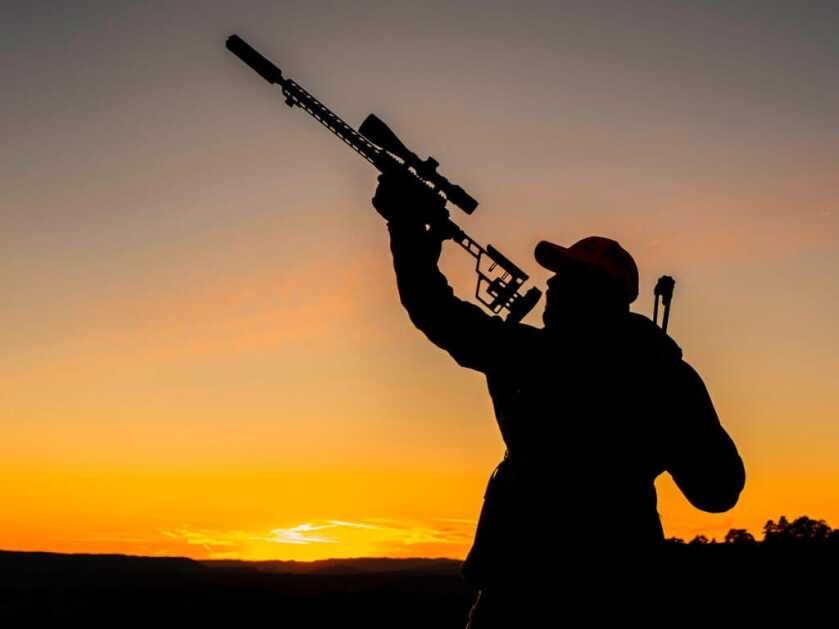
Last summer when SIG Sauer invited me to do an OTC (Over the Counter) Colorado elk hunt to test their new CROSS bolt action rifle in .277 SIG Fury, I was super excited. Having hunted elk for years both unsuccessfully and successfully I knew how much work it was and how hard OTC tags could be. I’d been doing them my whole life in Idaho.
I assumed that being SIG Sauer they’d hire a seasoned outfitter who’d pack us way in away from people and put us on the elk that he’d been scouting ahead of time. Hahahaha! That wasn’t the plan.
The guys going from SIG Sauer were normal guys that love guns and hunting. They are product line managers and people tasked with engineering new products for the company. They wanted to prove the CROSS rifle without the help of outfitters. We were going to be doing this on our own.
The plan was to backpack in 10-12 miles and set up base camps and hunt from there. I’ve hauled out elk on my back and still do it on occasion but my enthusiasm for shooting elk wanes dramatically when I know that it’s going to be more than a couple of miles each way. For me the math looks like this:
One bull elk ready to pack out equals approximately 300-350 lbs of meat. Head and antlers weigh another 50-60 lbs, and if you decide to take a cape, it can be upwards of 75 lbs. Certainly, the size of the elk is going to vary but let’s just say that it averages 400 lbs with everything. Four hundred lbs/five trips equal 80lbs per trip. Add in the essential gear and supplies: water, food, rifle, binos, spotting scope, warm clothes, pack, etc., and you’re easily packing 90lbs.
Let’s say you shoot your bull two miles from base camp and that base camp is 8 miles in. That means it’s 10 miles to the truck one way and then 10 miles back to the elk for another load. So 20 miles times five trips equal 100 miles and then you still have to get your camp that’s 8 miles in there, out. At least 50 miles of the 100 miles is weighted down with 90lbs.
Now add in bad weather, elevation, sleeping on the freezing ground, the Rocky Mountains, and you’re looking at an experience that will make grown men weep like babies.
Most of the SIG guys are from New Hampshire (which is at sea level) and didn’t have tons of experience hunting elk. I tried to explain some of the above to them but they’re a stubborn bunch and were convinced this could be done no problem.
After unsuccessfully explaining the Rocky Mountains I gave up and asked if I could bring my own horses. They had no problem with that at all.
During September and October, I was hunting antelope, deer, and elk in Idaho. In late October when the time came to join my friends at SIG, I loaded up my hunting buddy Nick (to take video), six horses, 14 bales of certified weed-free hay, pack-saddles, and just about everything else I could think of that I might possibly need, and set out for Colorado.

The hunt we were doing was the 2nd rifle hunt which meant it came after archery, muzzleloader, and an initial rifle season, which is the reason you could buy tags over the counter. The elk were pushed and pressured and were hiding way back in the mountains away from people.
We got a late start leaving Idaho and arrived at the pre-appointed meeting location in Colorado 14 hours later at 6:15 a.m. on Friday, October 18 after having driven all night. The first order of business was taking care of the horses, then sleeping for a couple of hours. The season opened the next morning on the 19th.
Up until this point, we’d only seen pictures of the CROSS rifle so we were excited to see and shoot this new platform.
The rifle didn’t disappoint. Even with SIG’s 10 baffle suppressor, it felt short and light and the trigger was phenomenal. Obviously, since this was in October 2019, it was one of six prototype CROSS rifles. Even being a prototype, it felt very smooth and I would have believed it if I’d been told that it was a full production rifle. The rifle we were using to hunt with had shot some impressive groups at the factory during R&D.
The Optic – SIG SIERRA3 BDX
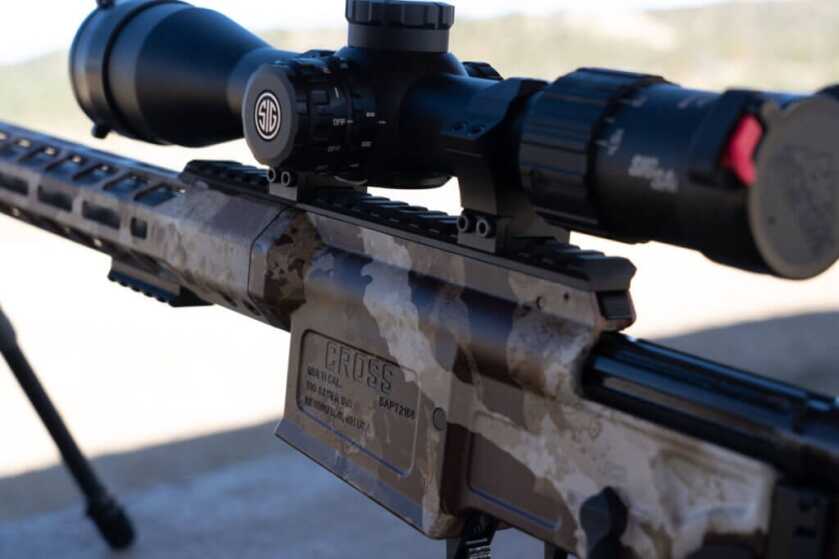
The scope mounted to our rifle was a SIG SIERRA3 BDX 6.5-20x52mm mounted in SIG rings. SIG’s BDX system pairs a rangefinder via Bluetooth with the scope. When you range a target, the rangefinder sends the range, angle, and ballistic data to the scope, which automatically displays the correct holdover on the reticle via an illuminated dot. I was skeptical but it worked perfectly. As a failsafe, the turrets on the SIERRA3 still dial, so if you have a battery problem or if the Bluetooth craps out, you can simply range and dial just like on any other system. The first thing I asked about was, “Where’s the extra batteries?” I was assured that they had some but that they shouldn’t be needed as the battery life in the scope is rated at 1,000 hours constant at mid setting and up to 20,000 hours with MOTAC. The batteries lasted the whole trip, as promised.
CROSS Rifle
The Cross rifle is a bolt action. But it’s not your grandpa’s bolt action. SIG started from the ground up and designed the action around the SIG .277 Fury round and they claim it’s the strongest modern 3 lug bolt action of its size in existence, especially when you consider its weight: 6.5 pounds.
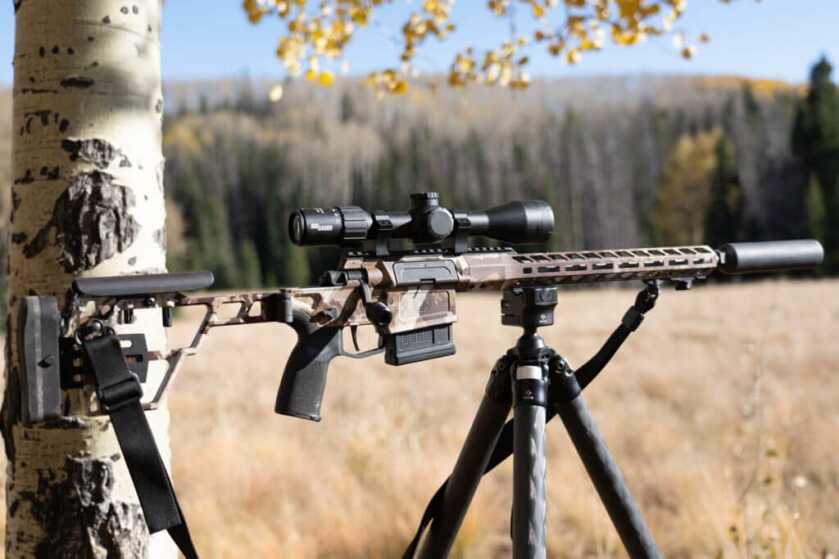
It looks like a chassis rifle but technically isn’t a chassis rifle. The receiver and stock are combined. The action doesn’t drop into the stock, rather it is part of the receiver. The receiver and stock are all aluminum, as is the handguard which wraps all the way around the barrel like an AR15. The handguard has MLOK slots for lights and lasers and any other shooting accessory one might want to attach.
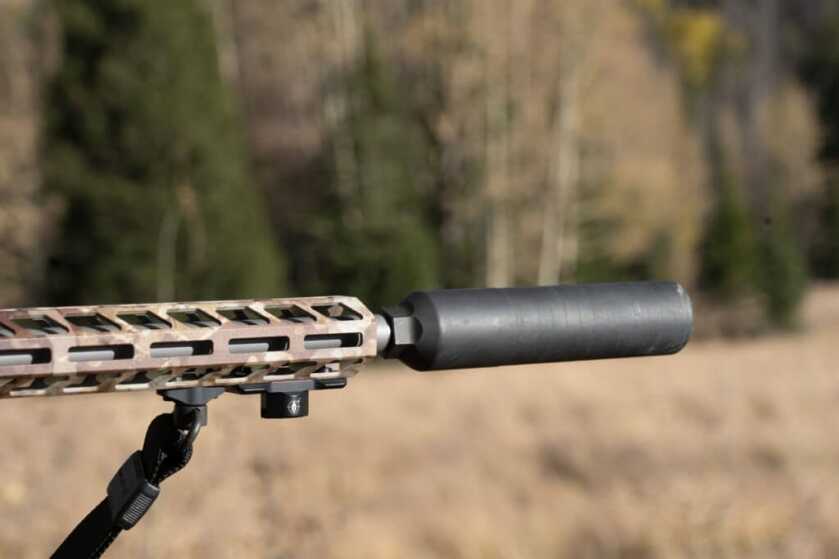
It’s my understanding that the receiver will be losing the dust cover because some of the guys on the mountain had it freeze shut (It was cold!) and felt it was unnecessary. I’m disappointed because I liked it.
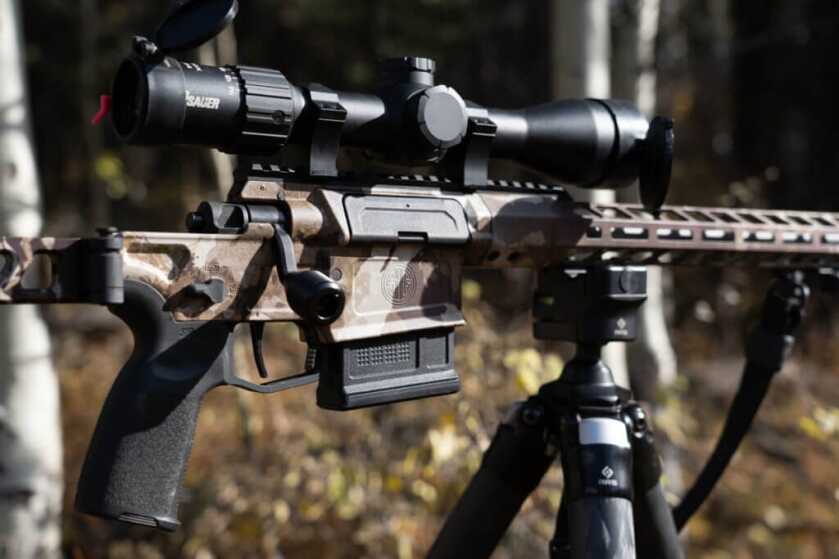
The receiver will ship from SIG with a 0 MOA scope base. A 20 MOA base will eventually be available from SIG.
BARREL
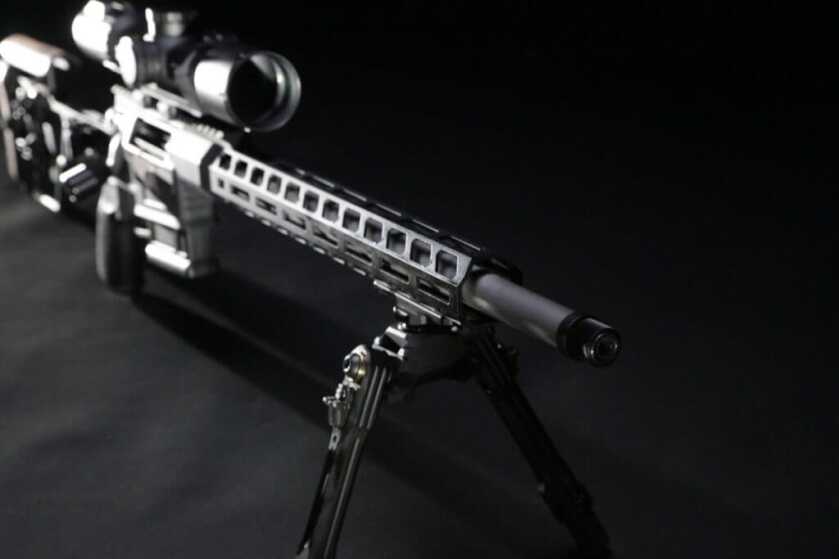
The CROSS rifle I hunted with had a 16-inch stainless steel 5R rifled barrel that was chambered in .277 SIG Fury. The barrels have an extension much like an AR-15 and this extension is pre-headspaced at the factory using a jam nut. The barrel is installed much like an AR-15 using a barrel nut.
The barrel is completely free-floating. All of the SIG Cross rifles will come with the barrel threaded 5/8-24 for muzzle brakes or suppressors.
It’s my understanding that SIG will have caliber exchange kits available in the future that will allow you to install a pre-headspaced barrel in a different caliber.
Also, it should be noted that while this rifle only weighs 6.5 lbs, it’s not because they skimped on the barrel; it still has a substantial amount of meat on it.
FINISH
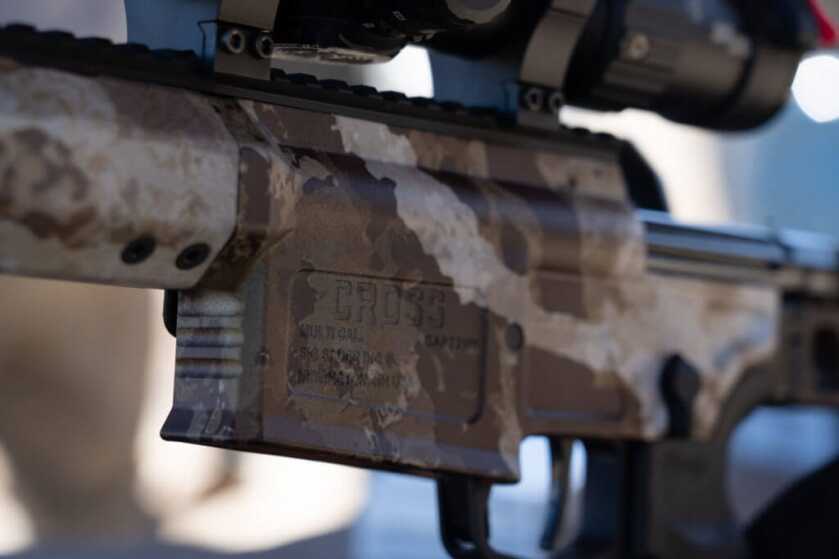
All of the aluminum parts on the rifle are anodized and then the hunting camo version, a FirstLite Camo, goes through a proprietary two-step coating process that adheres the coating to the aluminum. The coating is flexible but won’t flake. I actually slid down the side of 12,000 ft high peak (roughly a 30 ft of it, at least) I was climbing with the rifle on my back and it did nothing to the coating. It is tough — much tougher than the skin on my knees and elbows.
BOLT
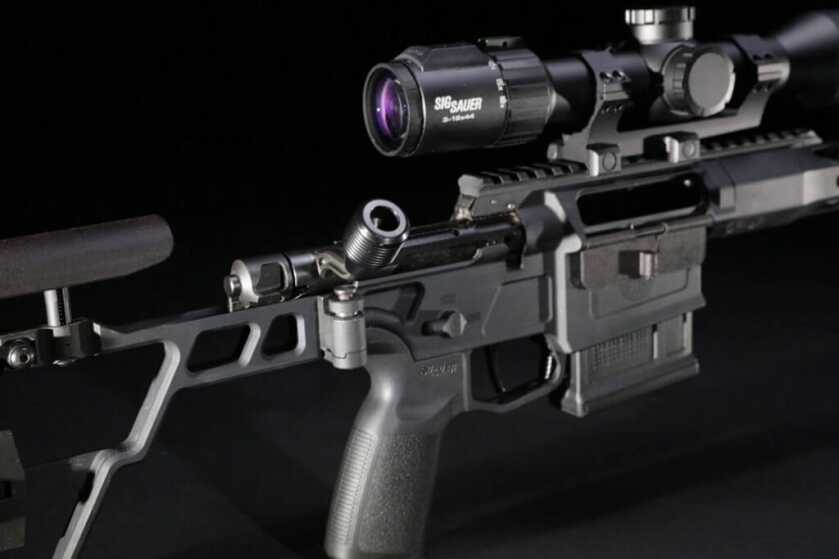
The bolt is a SIG Proprietary 3 lug with a 60-degree throw. The handle is quite easy to grasp and reminds me more of a tactical bolt handle than a hunting rifle but I like it. The bolt knobs are interchangeable and I’m told the production rifle will ship with a slightly smaller knob.
The bolt and barrel extension are made out of a stronger than average steel. It’ a medium carbon alloy steel that is Austempered, which means that it’s double tempered and extra tough. The prototype bolt was coated in DLC to reduce friction but that coating could change before production.
As a gun nerdy note, the trigger is cocked on the opening and closing of the bolt (approximately 2/3 on opening and 1/3 on closing). This allows the cocking to be done over a longer period and makes for an easier bolt throw. The bolt body is nitrided.
Primary extraction is done directly between the barrel extension and the bolt and is longer than a traditional Remington 700. Final cocking is done via a separate helix cam between the extension and bolt.
TRIGGER
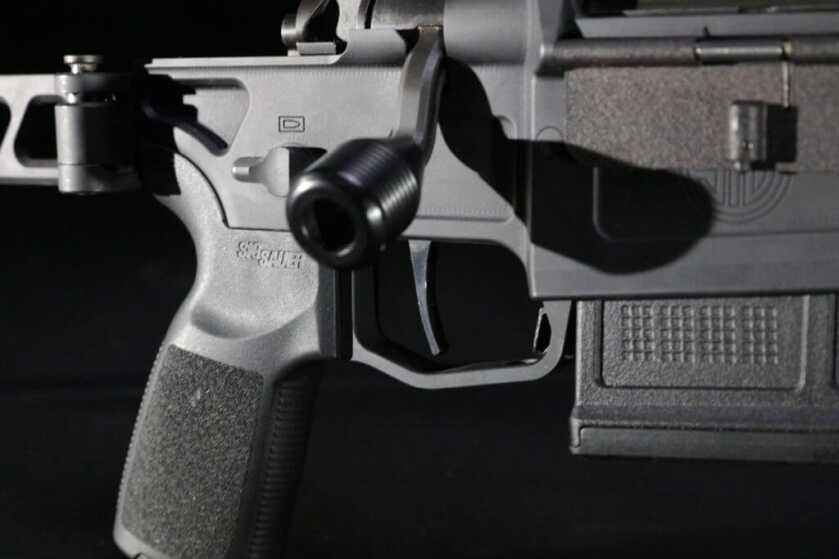
The Trigger is a proprietary two-stage, user-adjustable trigger that was designed completely in house at SIG. It’s adjustable between 2 lbs and 3 ¾ lbs. The 2nd stage will always be 1lb heavier than the first stage. For example: If you set the first stage to 2lbs then 2nd stage will be 1lb for a total of 3lbs.
SIG did extensive drop testing on the new trigger and it has exceeded the requirements for the NATO drop test and the SAAMI drop test. They also passed drop tests in more orientations than is required by the military.
The trigger shoe is in between a curved and flat trigger. My impression of the prototype rifle’s trigger was that it was longer than normal, which I liked. It felt incredibly smooth.
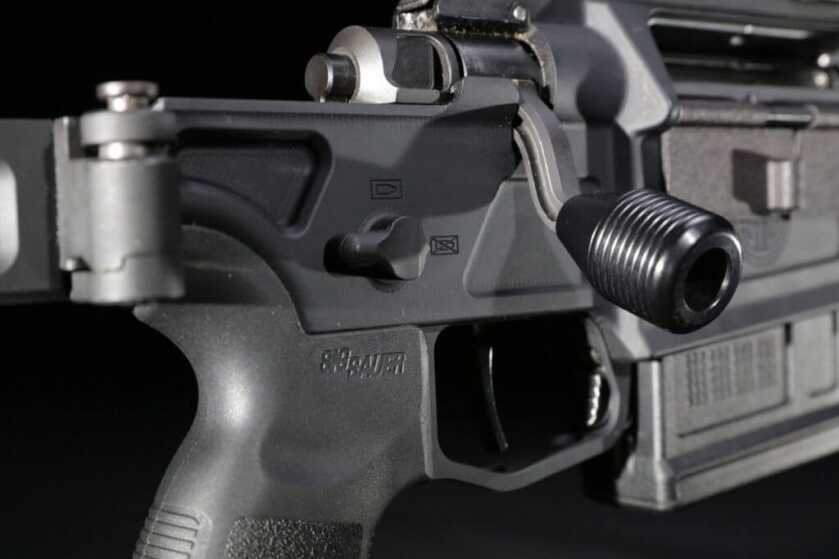
SAFETY
The safety is a two-stage safety. SAFE and FIRE. The safety (1) disengages and blocks the sear and (2) blocks the trigger bar, which gives the user feedback that the safety is on. The bolt can be worked with the safety on. The safety is ambi and is in essentially the same location as the safety on an AR-15 which I love because it’s so natural to use.
GRIP
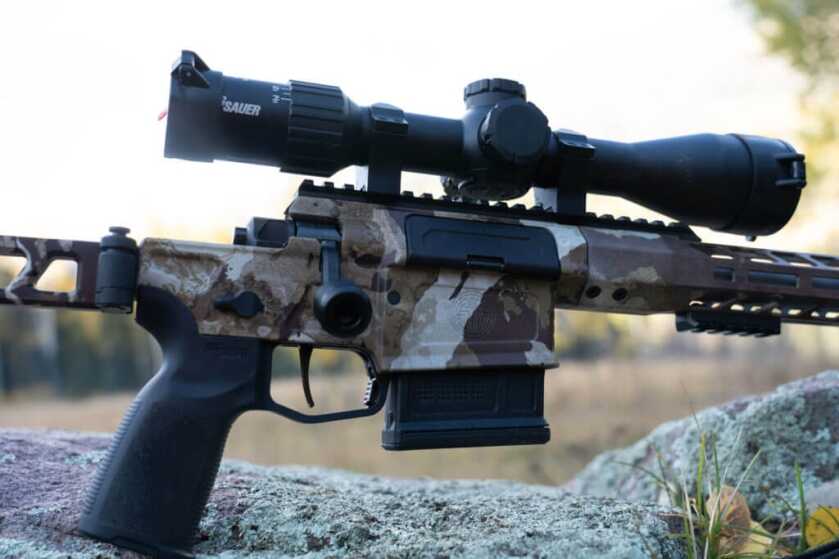
The grip can be replaced with any AR-15 grip.
MAGAZINES
The CROSS rifle feeds from AI pattern magazines. The plastic 5-round Magpuls were what we used on the mountain.
AMMO

The CROSS I hunted with was chambered in .277 SIG Fury, as mentioned, and was pushing a 140-grain hunting bullet at a little more than 2900 fps. That was prototype ammo. The ammo has already been bumped up to over 3000 fps. Check out this article from GunsAmerica on the .277 SIG FURY ammo.
STOCK
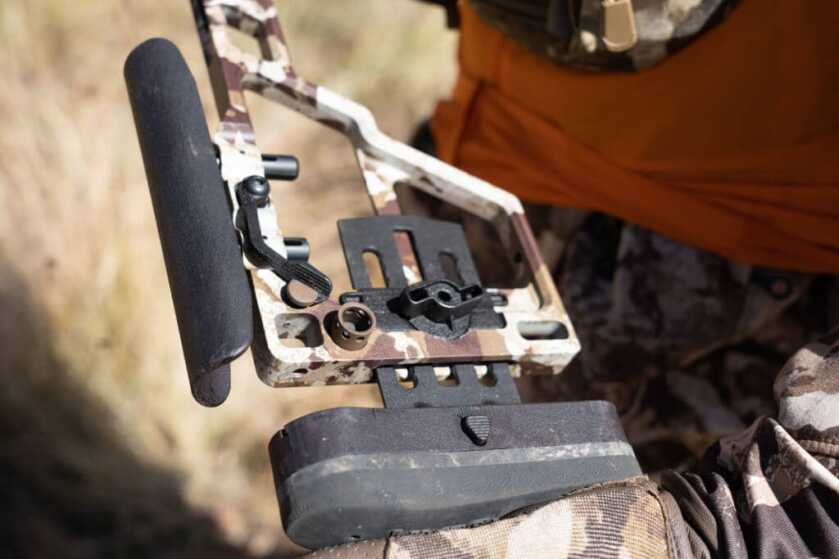
The buttstock is very adjustable! The comb and length of pull are adjustable without tools. One of my favorite features is that the comb is spring-loaded upwards. You can adjust this with one hand. Simply loosen, push down with a cheek until the comb is at the proper height and lockdown. Awesome! The comb can be adjusted one full inch. The length of pull can be adjusted from 12.8 to 14.8 inches.
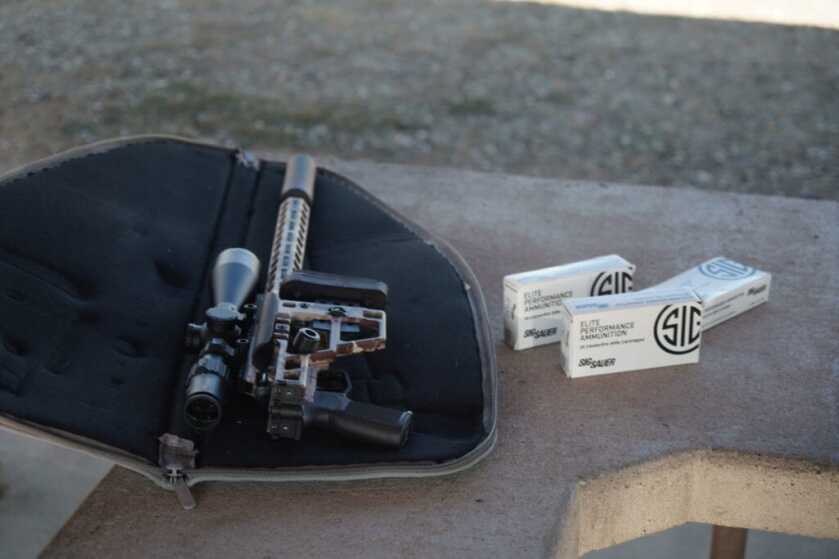
The stock folds and the hinge is reversible so the stock can fold either right or left. The stock also locks in the folded position. I absolutely loved the folding stock. With the stock folded the CROSS rifle fit in my backpack even with a suppressor on it. The stock locks up tight with no perceived play or wobble.
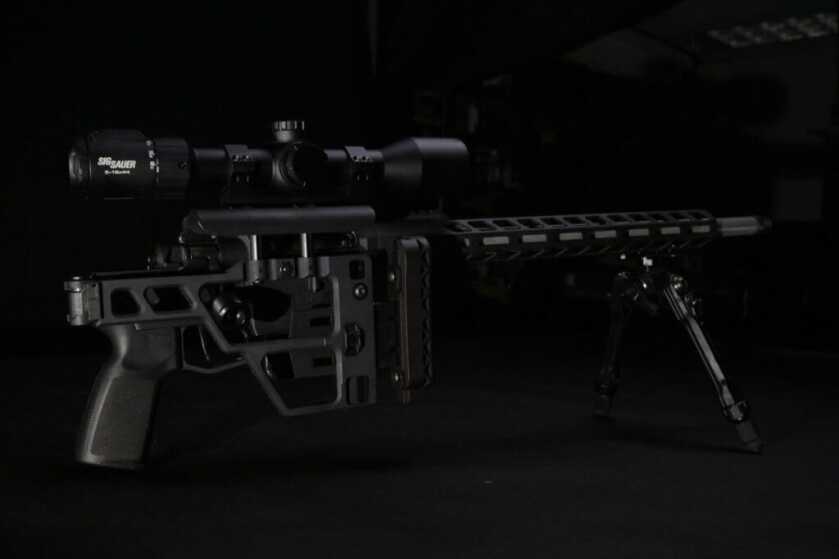
The buttpad can be canted 7 degrees left or right and is adjustable up or down just over an inch.
The QD on the stock is reversible to either side.
The bottom of the stock comes with an interface for a bag rider or an MLOK rail.
MY IMPRESSIONS OF THE RIFLE
I packed the rifle for over a week on my back with a sling, in a backpack, and on a horse. I loved the weight. It’s in the sweet spot where it’s not to light to shoot but is still easy to carry. The rifle also conveniently fits in my saddle scabbard.
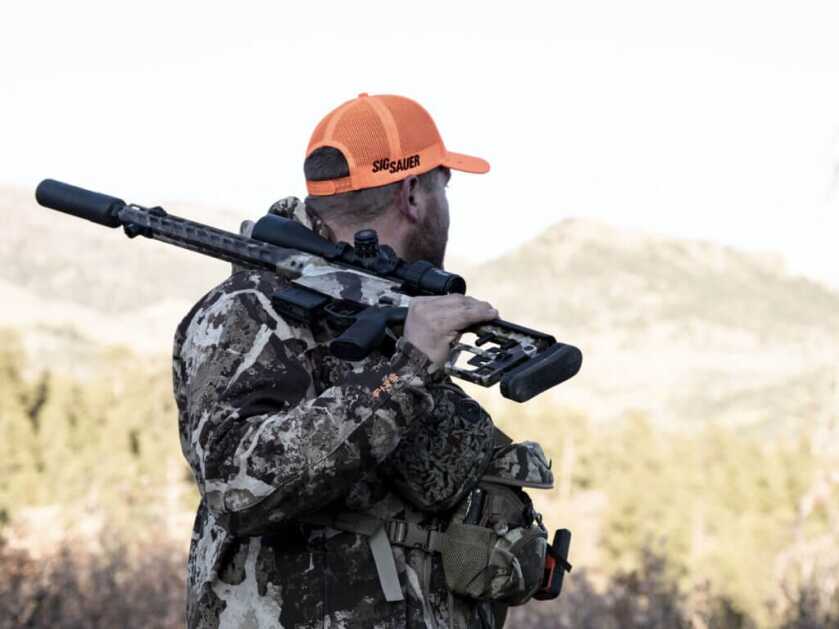
The rifle balances well. The bolt is easy to work and the trigger was fantastic. With all of the stock adjustments, it’s easy to get the rifle to feel like it was made just for you.
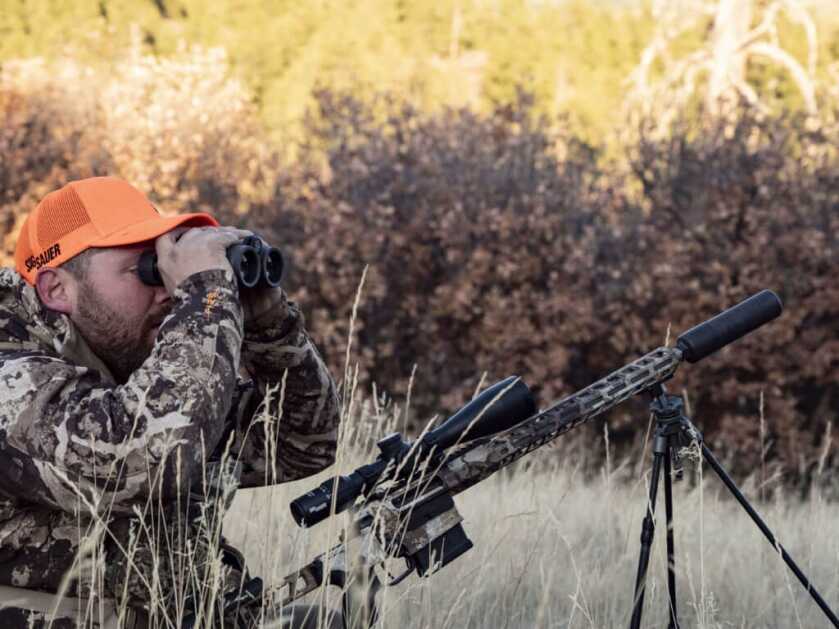
I never fired the rifle without the suppressor but with the suppressor, the recoil was not even noticed. I was able to spot my own shots through the scope as long as I held onto the rifle.
When the production CROSS rifle becomes available this Spring we’ll do a full review, complete with groups and pictures of the rifle disassembled. It wouldn’t do any good to do that on a prototype as things have already changed.
BACK TO THE ELK STORY….
Our original plan had been to pack the horses into the area that we wanted to hunt and camp. However, the weather had been cold and feed was somewhat sparse. We hadn’t come prepared to pack pellets and I was worried about how the horses would do on the frozen grasses (freezing saps the nutrients and energy from the grass). The next plan was to stay at a trailhead but the trailheads were crowded with people and there wasn’t any water at them. We ended up staying in town at the rodeo grounds with the horses where they could eat and drink all they wanted. I believe that if you take good care of your animals that they’ll take good care of you.
We were up early opening morning and at the trailhead packing to head in at 3:30 a.m. It had rained the day before and everything was slick and iced up. The temperature was a cold, damp, 10 degrees at the trailhead and it got colder as we climbed in elevation.
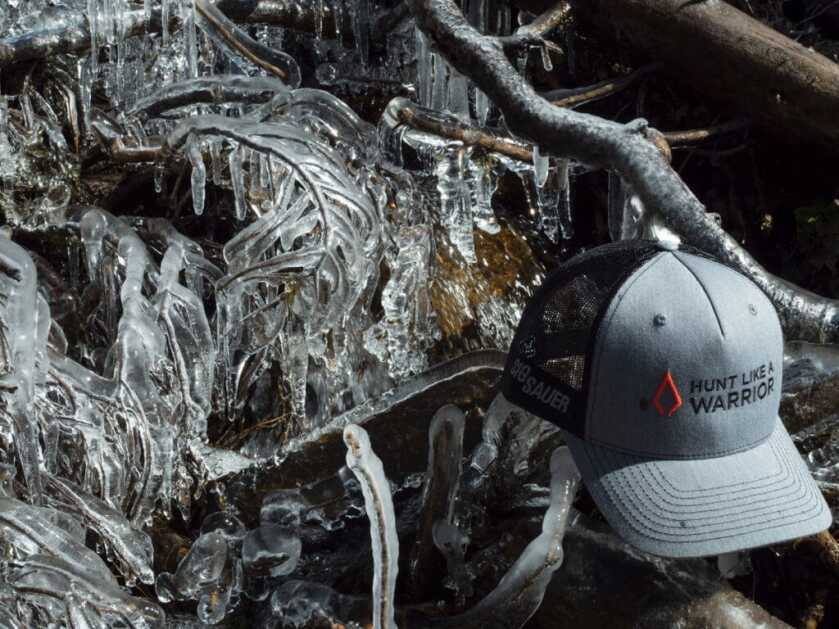
We followed an ATV trail for a couple of miles before it turned into a single track which eventually turned into a Wilderness Area.
Just before daylight and 8-10 miles in, we turned off the trail and started riding the horses through deadfall. The deadfall continued to get worse and worse so we eventually stopped and tied up the horses.
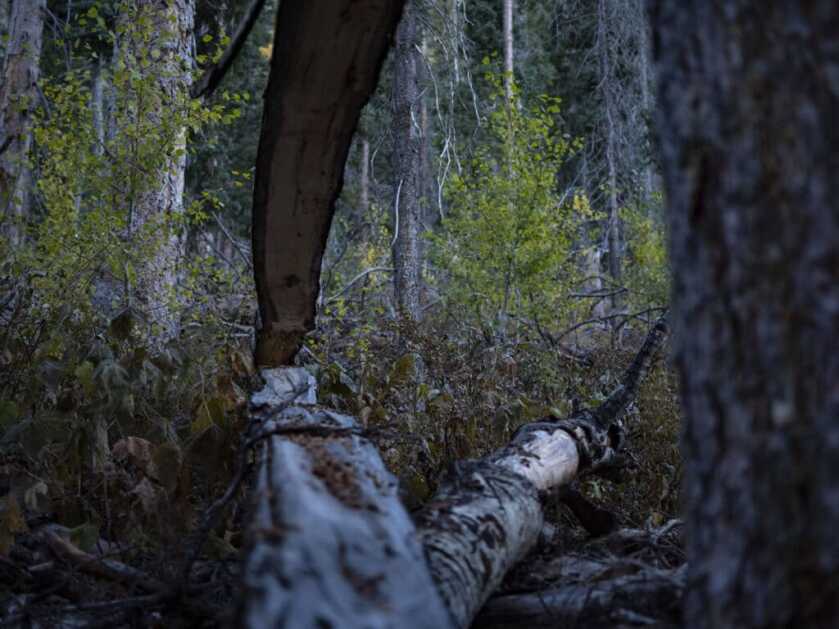
We climbed slick frozen deadfall to get into the mouth of a huge avalanche slide that allowed us to see up the mountain and into a huge canyon. Previous avalanches had piled deadfall higher than two-story buildings and the logs and boulders all had a thin sheet of ice which made traversing them dangerous. We crossed the icy creek at the bottom of the avalanche slide and started glassing the mountain with binoculars.
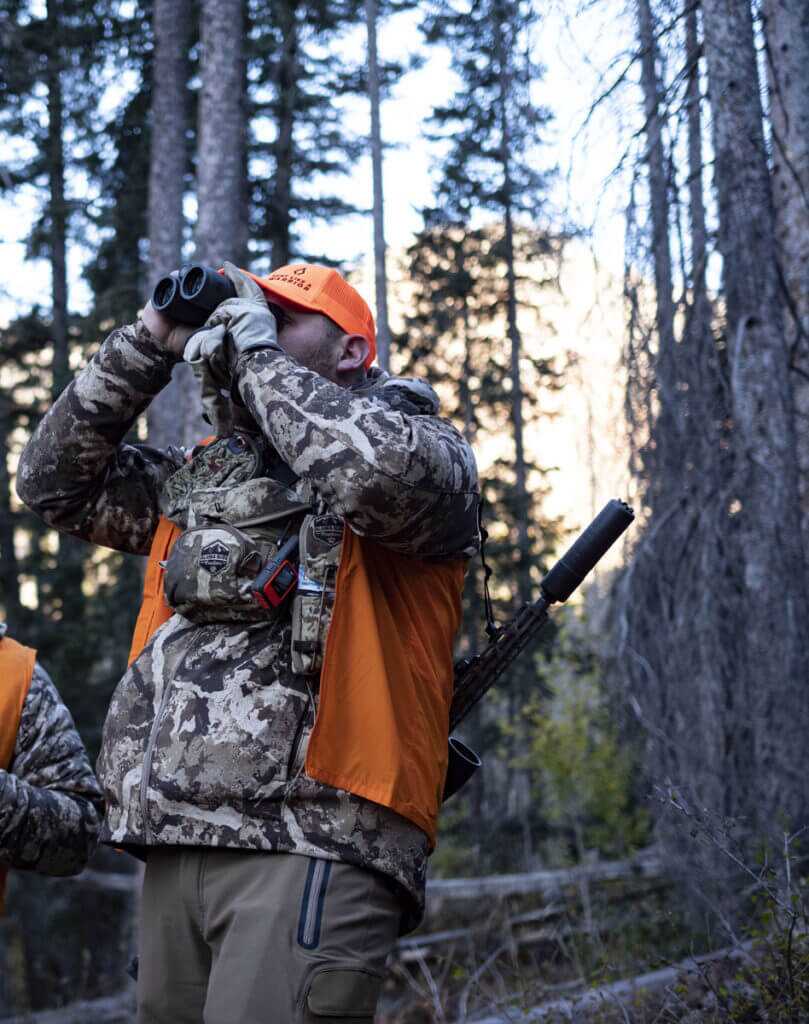
SIG had outfitted us with a set of binoculars and I hadn’t been glassing long before I saw the backend of an elk sticking out from a tree at a little over 2,500 yards. SIG rangefinders read a long way!
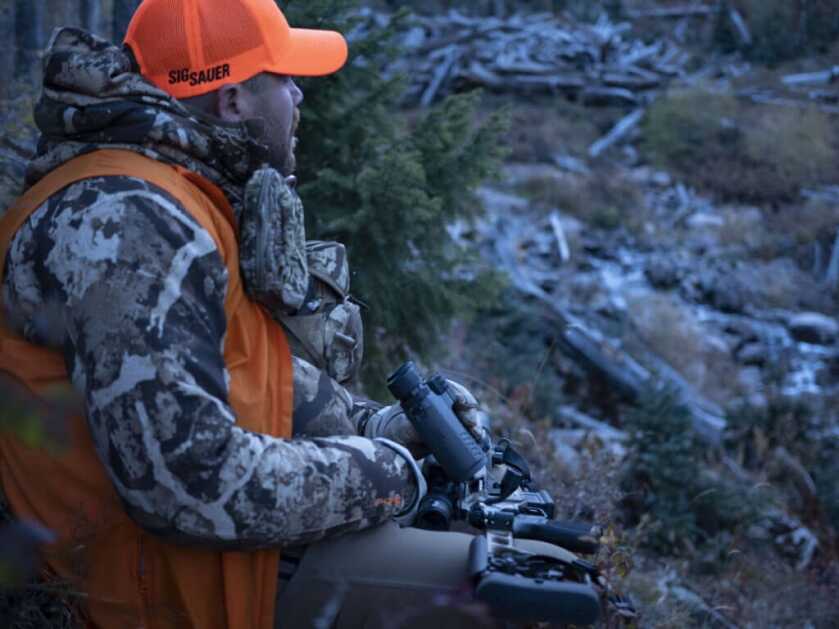
That was the good news. The bad news was that the mountain he was on was almost 3,000 feet straight up! The elk was just below 12,000 ft.
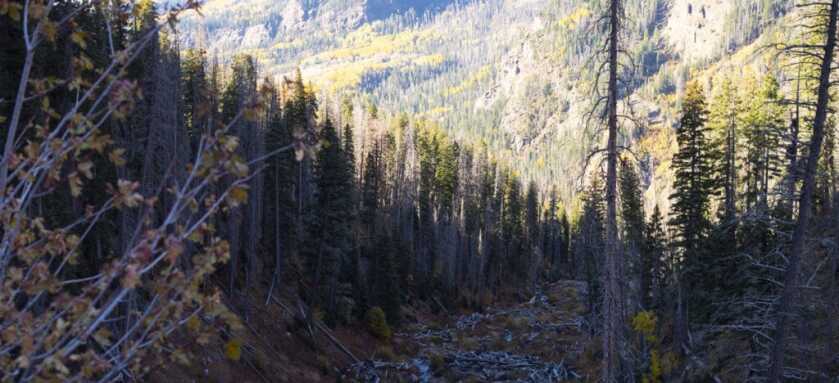
We continued to climb up the avalanche chute. From a few hundred yards farther up we could see more elk. The original elk was a large bull. We couldn’t count individual points at that distance but could see his horns move above his head. We had a look at him through the riflescope, which had 20 power, and guessed that he was in the 350-inch range or bigger for score. He was big. We continued climbing.
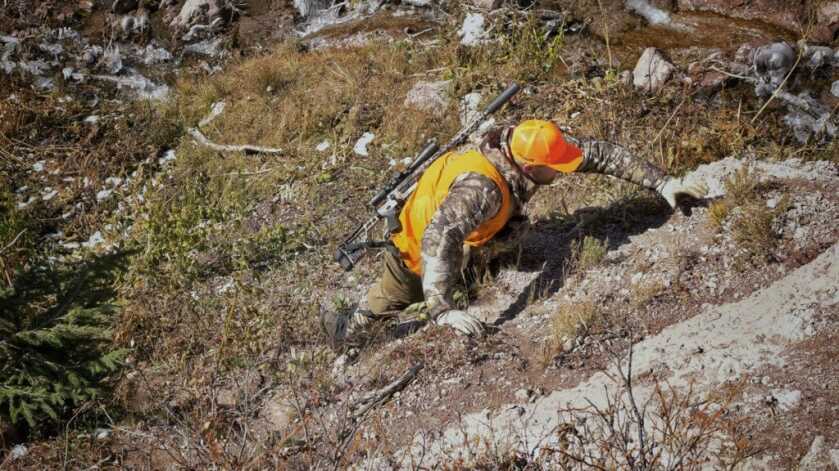
It took us most of the day to climb the mountain. We’d spotted the bull somewhere around 7:30 a.m. and by the time we got anywhere near where he’d been, it was probably 3:30 p.m. We’d seen glimpses of elk all day while we climbed and had cows running around underneath us. We each had a water bottle, a granola bar, and some deer jerky. The rest of our food was with the horses.
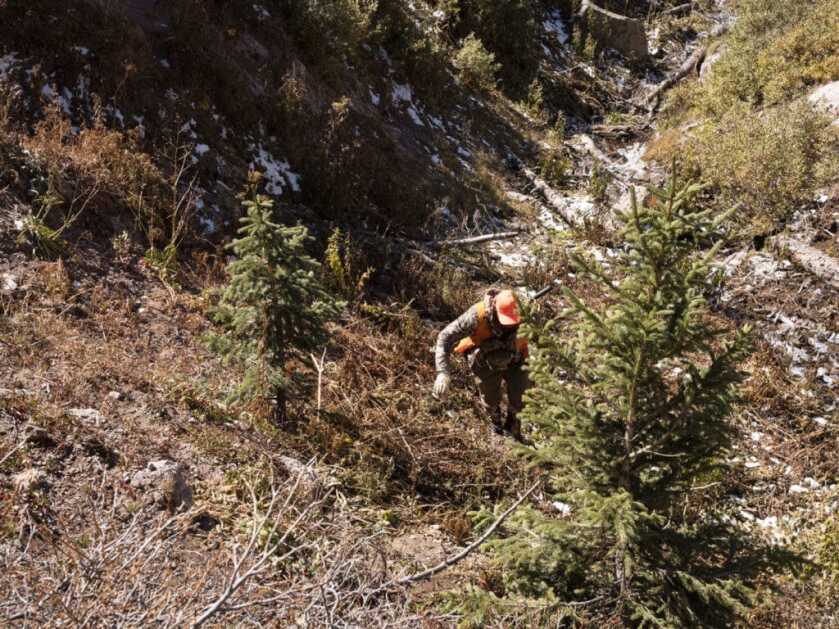
Somewhere around 11,000 feet both Nick and I got a little lightheaded and dizzy. The elevation was a butt-kicker. The climbing was straight up, hand over hand. It was exhausting. Our boots didn’t dig in well due to the ice that had covered much of the ground. I’m pretty sure it never got above about 20 degrees all day. At one point I slipped and fell. I slid down the mountain and smashed the rifle slung on my back pretty hard. It was a lucky place to fall because some of the places I could have fallen had nothing to stop me.
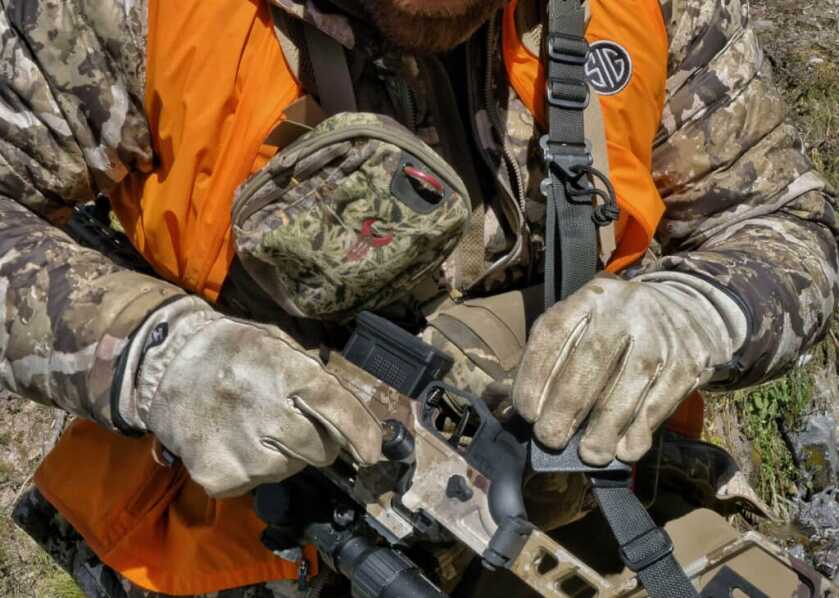
We went slow simply because going fast was not an option and we did our best to keep the wind right. We continuously glassed. When we got to the general vicinity of where the bull had been we couldn’t see him or any more elk. We decided we needed to get higher and climbed all the way to the top so we could glass down.
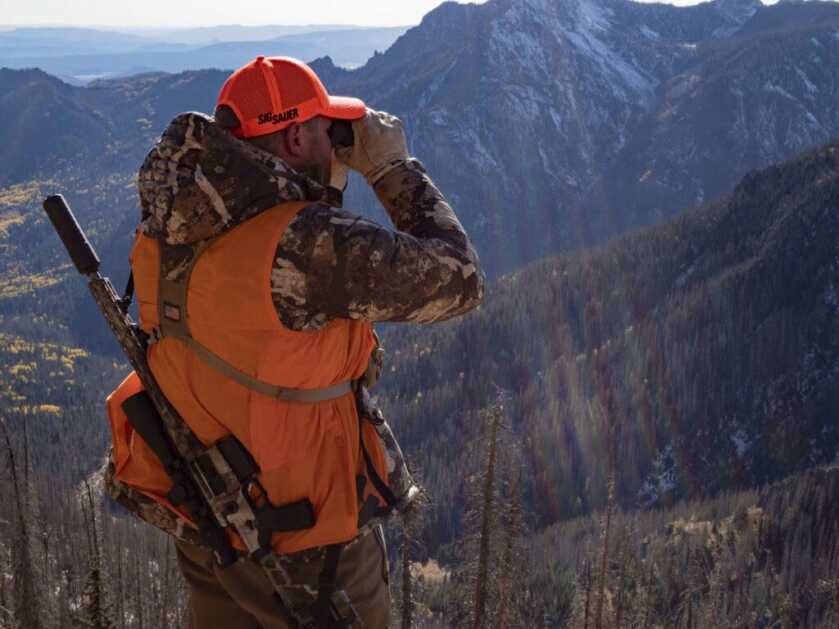
We ended up working our way all the way down the ridge and into the next canyon glassing as we went. We worked back across the tops of the avalanche chutes. Going was slow because it was slick and steep.

It was just getting dark when we spotted some cows in the bottom of the chute we were glassing into. We watched them for a couple of minutes and made sure the bull wasn’t there before side-hilling over into the next chute.
It was just about dark when I spotted a bull just under 400 yards down the chute. He appeared to be alone. I knew he wasn’t the big bull we’d seen but this was an OTC tag and I knew he was a decent bull. I figured we had about 4 minutes of legal light left. I told Nick, “I’m going to shoot him,” and sat down and tried to get steady on my knees for the shot. Nick got me a range and then started trying to film. I couldn’t get steady and told him I needed his camera tripod. He dumped his camera off and gave me his tripod (We got no video of the shot). I balanced the CROSS rifle on the tripod and lined up for the shot. He was broadside to us and walking to our left. Nick let out a cow call and he stopped and looked up towards us. I aimed right behind his shoulder.
I don’t remember feeling the trigger but remember hearing the bullet hit the elk. It was too dark to tell where I’d hit him but he was still on his feet so I worked the bolt and aimed for his neck. Whaaap! No doubt it was another hit. He was still standing so I repeated the procedure and followed it up with another hit to the neck. The two hits to the neck were especially loud. Hearing the bullet hit is one of the best things about hunting with a suppressor. I got up and started running down the chute because I didn’t want him getting away on that mountain in the dark. I heard Nick yell out, “He’s down!”

By the time we got to the bull, it was completely dark and getting really cold. We had to use headlamps to find him. We took a couple of quick photos and I proceeded to field dress him. The first shot was right behind the shoulder and through the lungs. He was dead at the first shot but I just didn’t know it. Better safe than sorry. The two shots in the neck were unnecessary.
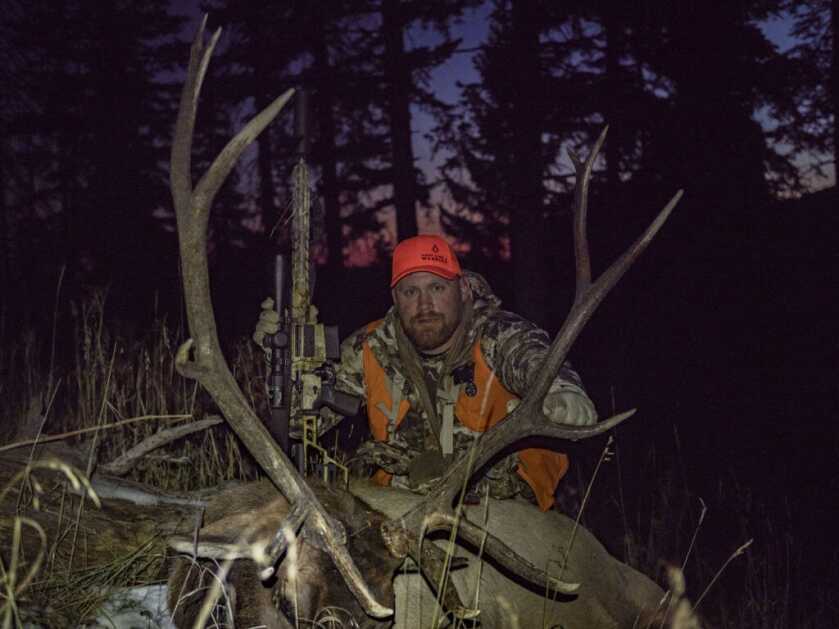
We propped sticks under his neck and legs so that cold air could flow under and into him and started hiking down to the horses. It was a long steep, deadfall-ridden walk. About halfway to the horses my phone running onX maps died and we couldn’t use it to navigate. The deadfall was so bad that we couldn’t walk in a straight line and it was hard to hold a course. We eventually found the horses and started the long, cold ride out.
When we got back to the rodeo grounds and had fed the horses and cleaned up, it had been 24 hours. It got to five degrees that night.
We didn’t start recording our track with GPS that morning until we had gone a few miles and my phone died before we got back to the horses that night but it still logged us at 18 miles. Best guess is that we did 22-26 miles during that 24 hours between walking and riding. That’s a long way in steep, rough, cold mountains.
The Packout!

When we went back in to retrieve the elk, John, the VP of Product Management at SIG went with us. We rode in and brought along the pack horses. We spent most of the day making a trail in and out of deadfall, breaking branches, sawing logs, and jumping horses over deadfall. We couldn’t get the horses to the elk and had to pack the elk in backpacks through two creeks back to the horses. John’s help was much appreciated. He’s a tough son of gun and impressive in the mountains for a guy from NH.
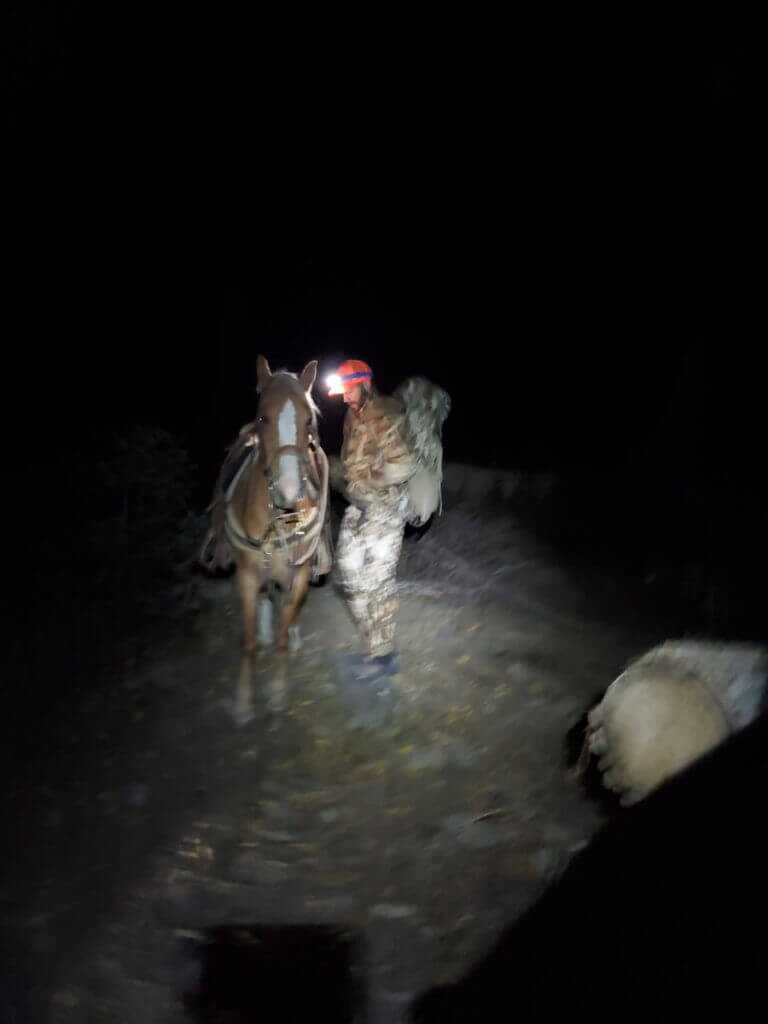
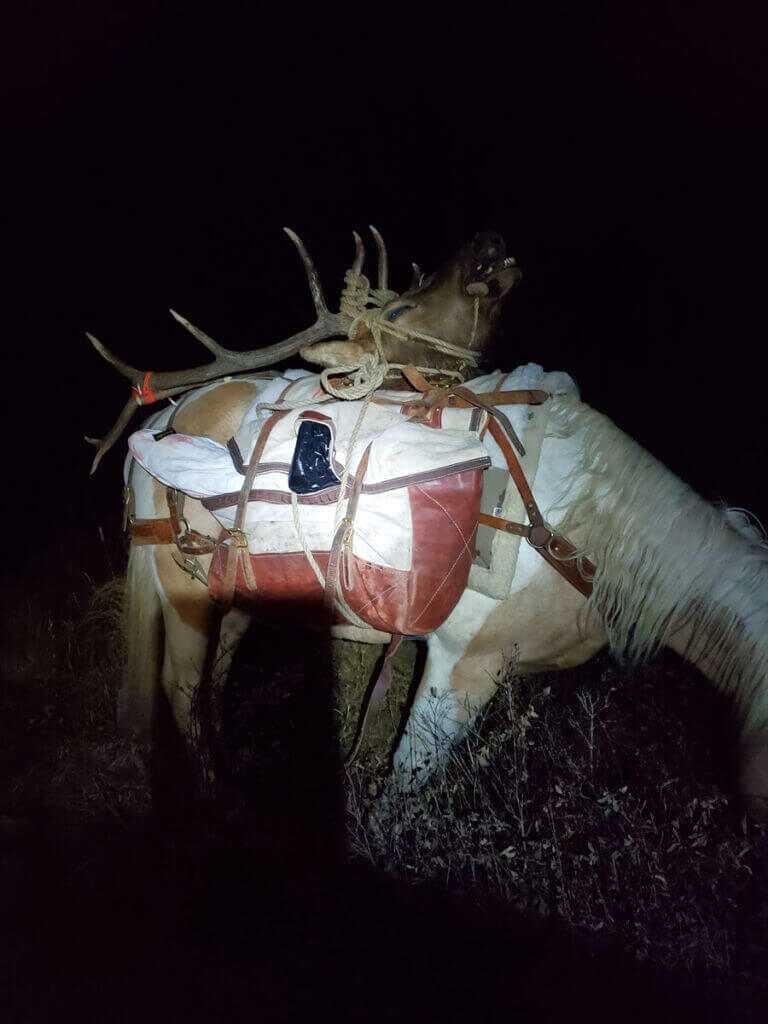
It was well after dark by the time we had the elk packed on the horses and started back through the maze of steep nasty ravines and deadfall. Even though we’d marked our path through and over the deadfall in, we struggled to stay on it in the dark with the horses. We had a few small wrecks but nothing serious.
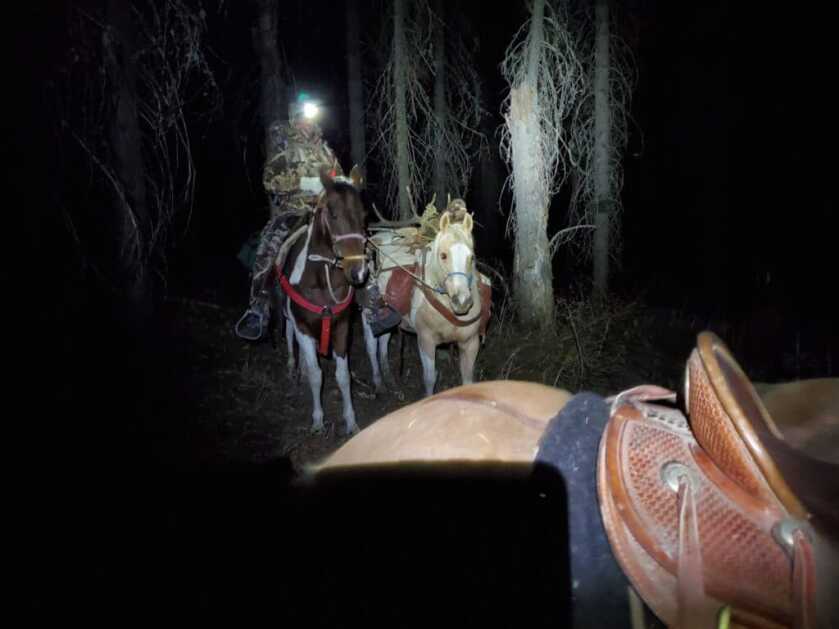
We got back to the horse trailer at about 1:30 a.m. and were in bed by 3:30 a.m.
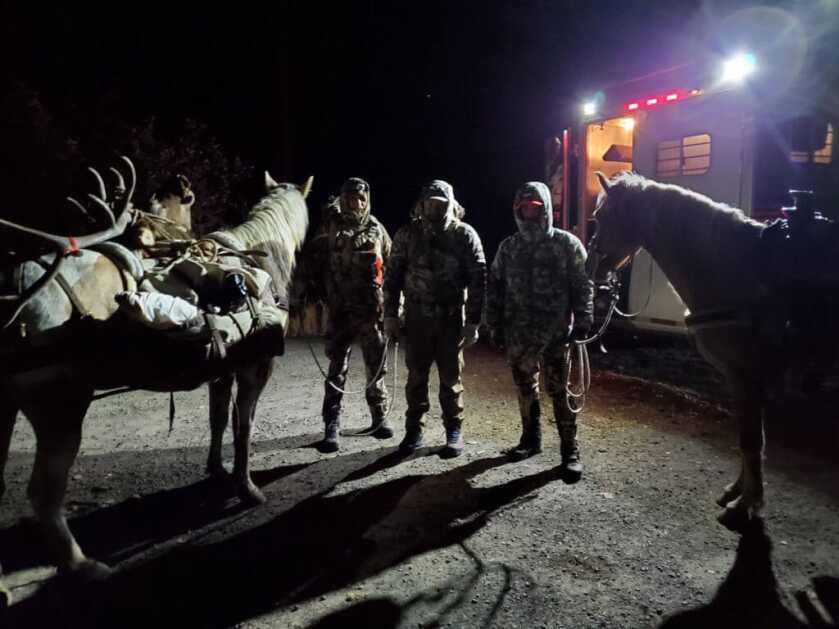
We continued to hunt with the SIG Cross for the next week because Nick had a tag. However, we weren’t all that interested in climbing back up that 12,000 ft summit, despite the fact that’s where most of the elk we spotted were gathering. We tried other, more accessible areas but to no avail.
Several other hunters with the SIG group shot bulls and we helped pack them out with the horses. In total, four bulls were shot during our trip. No elk were wounded, no people died, and everyone that went had an experience that they’ll never forget.
SIG used the feedback from the hunt to make minor changes to the CROSS platform. I’m looking forward to seeing the finished product.
Learn more about the SIG CROSS rifle at SIG SAUER

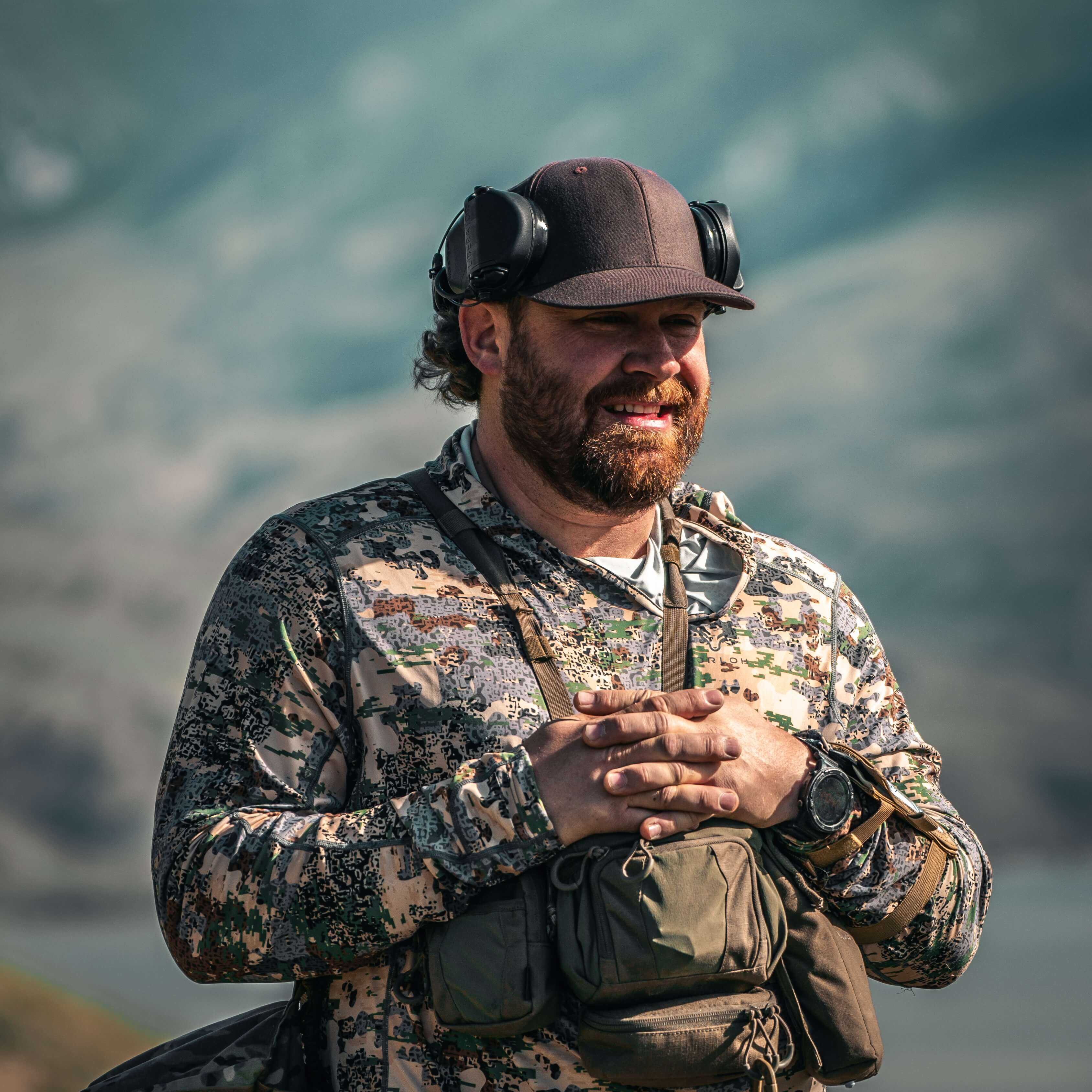
I enjoyed this article very much. It was well written and clearly illustrated. You and the crew you went with put your hearts and backs into this hunt. Congrats on the nice bull.
I’ve not seen anything mentioned about whether or not the .277 Sig Fury cases can be reloaded. If so, I think sales will be brisk.
Norman
Reno, Nevada
WOW!!! What an adventure. While the information about the Cross Rifle was great, I really enjoyed reading about the entire elk hunt and the climb up and down the mountain — WELL DONE 🙂
Apologize but I did not see the name of the suppressor used in this hunt.
what was the name or manufacturer of the suppresser and the model number.
Stay safe … shoot straight … excellent article…
All my guns are Sigs.
Mr. Pearce, what suppressor were you using? You state the 10 baffle but I’m trying to isolate whether it was the TI variant or just the regulars incolnel. Considering the wait times with the ATF it would be awesome to get an order in early on before the rifle even comes out however no information has been published about the suppressor requirements.
Looks like the ten baffle of the SRD762 Ti DT so it would have been titanium, but I’m going just on what I saw in the pictures. Great can.
Hello True,
A great article with every word !
In addition to having great interest as to exactly when and where I can purchase the Cross rifle in 277 ( street price, of course, and the answered call at Sig Sauer said that the only info they had is that which is posted on the web site). Sig said that they wouldn’t know any more until after the shot show, I am equally interested in ammo information ( varieties,pricing,when & where) . I would the info as soon as you can get it as I am planning ahead with my finances. Also, could you tell me something about the suppressor that you used with your opinion about it.
Ed Porter
Michigan
I lived for many years in Arizona before it became so crowded, and found mules to be superior to horses for mountain hunting. In fact, I had one red roan mule that would go places I couldn’t. He seemed to know when I was making a stalk, and really made less noise than I did. I sold him when I moved out of Az. and have regretted it every day since. He was bomb proof as far as anything spooking him, although he was nervous around cougar. I also had two pack mules that would follow the roan off a cliff, but weren’t trust worthy to hunt from. I had many friends that although warned ended up with bruised knees. The roan would not hit your knee or go under anything that you would not clear.
i’d like to know what wilderness area you all hunted if it’s not a secret? how far did you guys actually pack the elk on your backs, not the horses? your description of your perceived elk hunt at the beginning had no mention of horses to pack out the elk? i’ve done both & is much easier with the horses for sure! the reason we quit using horses was just as your story starts out, you saw the elk over a mile away & you have to leave the horses & go “up” after the elk, but you have to come back down to the horses & to take care of them & etc.
Congratulations on the successful hunt! I am going on my 1st elk hunt this year in Montana. I new these hunts can be grueling. The 277 Fury sounds promising. I’ll be using a 270 wsm. Any chance SIG will make these rifles for lefties?
Yea I’m curious about the lefty question also. Also wondering if their will be other caliber options.
6.5 and 308 are available.